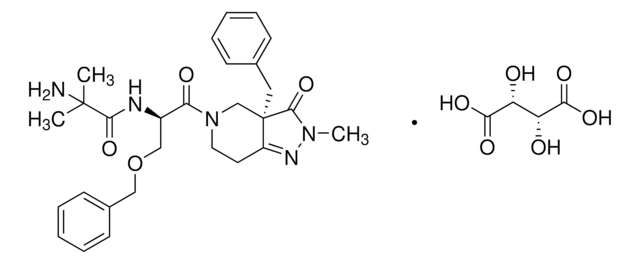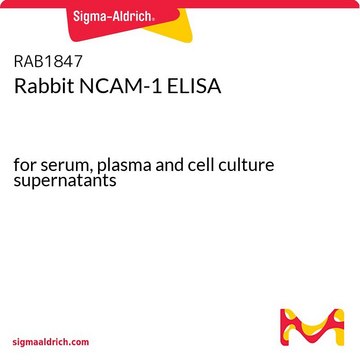AG265
Neural Cell Adhesion Molecule, chicken
Synonym(e):
Cell adhesion molecule
Anmeldenzur Ansicht organisationsspezifischer und vertraglich vereinbarter Preise
Alle Fotos(1)
About This Item
UNSPSC-Code:
12352203
eCl@ss:
32160702
NACRES:
NA.41
Empfohlene Produkte
Biologische Quelle
chicken
Qualitätsniveau
Form
liquid
Hersteller/Markenname
Chemicon®
Konzentration
0.5 mg/mL
Methode(n)
western blot: suitable
NCBI-Hinterlegungsnummer
UniProt-Hinterlegungsnummer
Versandbedingung
dry ice
Angaben zum Gen
chicken ... NCAM1(428253)
Allgemeine Beschreibung
Product Source: Embryonic Chicken Brain. Molecular Weight: 200-250 kDa, when treated with Neurminidase, 140-180 kDa. A breakdown product of 160 kDa may also be visible.
The neural cell adhesion molecule (NCAM) was the first cell-cell adhesion molecule to be identified, isolated, and sequenced. Structurally, the extracellular portion of NCAM is comprised of five IgG-like domains followed by two fibronectin type III repeats. Because of its history, NCAM is considered to be the classic example of the family of cell-cell adhesion molecules that are structurally related to immunoglobulins. There are three forms of NCAM molecules that differ in their mode of attachment to the plasma membrane: ld, transmembrane form with large cytoplasmic domain; sd, transmembrane form with small cytoplasmic domain; ssd, GPI linked to the external surface of the plasma membrane. NCAM is unique in that the molecule can bear large oligosaccharides containing long chains of polysialic acid. Functionally, NCAM mediates cell-cell adhesion both in neural cells and a variety of other cell types. NCAM-mediated adhesion occurs by both a homophilic mechanism (NCAM to NCAM) and a heterophilic mechanism in which NCAM binds to heparin sulfate proteoglycans. The polysialic acid in NCAM interferes with NCAM-mediated cell-cell adhesion. Moreover, the polysialic acid on NCAM fills up so much of the space between cells that it also interferes with cell-cell adhesion mediated by other adhesion molecules. It has been suggested that the polysialic acid on NCAM is involved in maintaining plasticity in interactions among neural cells. NCAM is expressed at a wide variety of sites during embryonic development both in the nervous system and other tissues. Its expression is more restricted in the adult brain; however, it is still expressed in certain regions. NCAM expression is also associated with certain diseases. In particular, it is considered to be a marker for Wilms tumor and for small cell lung carcinoma. Chemicon′s preparation of NCAM is derived from embryonic chicken brains and is composed of polysialic acid-rich molecules. Neuraminidase treatment of the preparation reveals that it contains mainly the ld form of NCAM with a smaller amount of the sd form.
Anwendung
Research Category
Neurowissenschaft
Neurowissenschaft
Research Sub Category
Wachstumskegel & Axonlenkung
Neurofilament & Neuronen-Stoffwechsel
Wachstumskegel & Axonlenkung
Neurofilament & Neuronen-Stoffwechsel
Source: Embryonic Chicken Brain. Molecular Weight: 200-250 kDa, when treated with Neurminidase, 140-180 kDa. A breakdown product of 160 kDa may also be visible.
Physikalische Form
Purified NCAM in 15 mM octylthioglucoside/ 0.5 M NaHCO3. Contains no preservative.
Lagerung und Haltbarkeit
Maintain at -20°C in undiluted aliquots for up to 6 months after date of receipt. If required for in vivo applications, detergent can be dialyzed away.
Rechtliche Hinweise
CHEMICON is a registered trademark of Merck KGaA, Darmstadt, Germany
Haftungsausschluss
Unless otherwise stated in our catalog or other company documentation accompanying the product(s), our products are intended for research use only and are not to be used for any other purpose, which includes but is not limited to, unauthorized commercial uses, in vitro diagnostic uses, ex vivo or in vivo therapeutic uses or any type of consumption or application to humans or animals.
Lagerklassenschlüssel
12 - Non Combustible Liquids
WGK
WGK 2
Flammpunkt (°F)
Not applicable
Flammpunkt (°C)
Not applicable
Analysenzertifikate (COA)
Suchen Sie nach Analysenzertifikate (COA), indem Sie die Lot-/Chargennummer des Produkts eingeben. Lot- und Chargennummern sind auf dem Produktetikett hinter den Wörtern ‘Lot’ oder ‘Batch’ (Lot oder Charge) zu finden.
Besitzen Sie dieses Produkt bereits?
In der Dokumentenbibliothek finden Sie die Dokumentation zu den Produkten, die Sie kürzlich erworben haben.
Adhesion among neural cells of the chick embryo. II. Purification and characterization of a cell adhesion molecule from neural retina
Thiery, J. et al.
The Journal of Biological Chemistry, 252(19), 6841-6845 (1977)
Unser Team von Wissenschaftlern verfügt über Erfahrung in allen Forschungsbereichen einschließlich Life Science, Materialwissenschaften, chemischer Synthese, Chromatographie, Analytik und vielen mehr..
Setzen Sie sich mit dem technischen Dienst in Verbindung.








